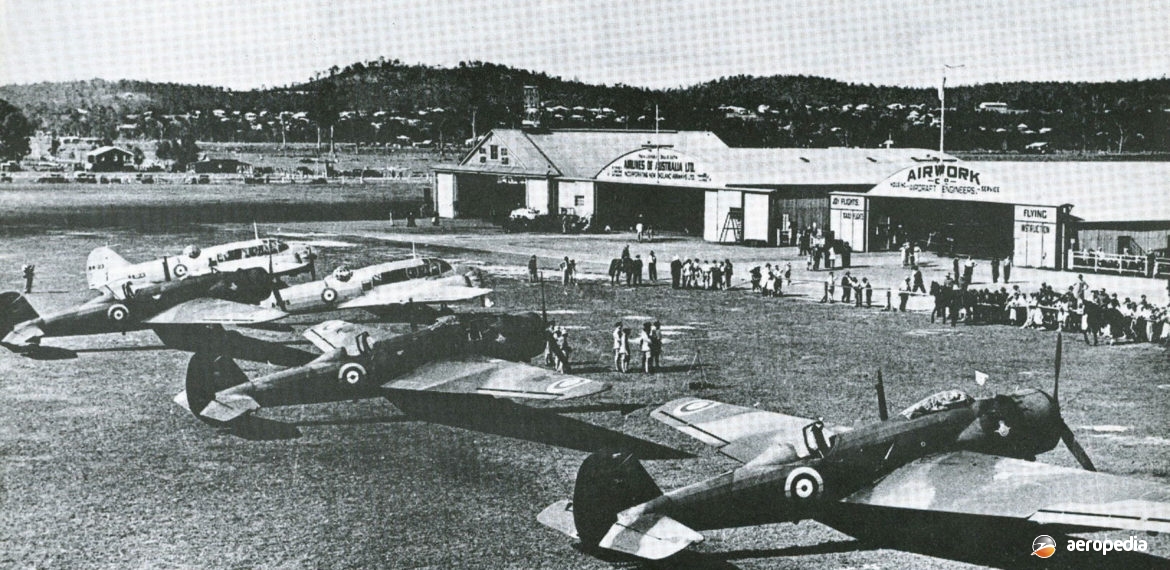Photograph:
Three RAF Vickers Wellesleys after arrival in Australia (RAAF Museum)
Country of origin:
United Kingdom
Description:
Long-range single-engine bomber
Power Plant:
One 690 kw (925 hp) Bristol Pegasus XX nine-cylinder air-cooled radial engine
Specifications:
- Wingspan: 22.74 m (74 ft 7 in)
- Length: 11.96 m (39 ft 3 in)
- Height: 4.67 m (15 ft 3½ in)
- Wing area: 54.5 m² ((586 sq ft)
- Max speed at 6,000 m (19,680 ft): 367 km/h (228 mph)
- Cruising speed at 4,572 m (15,000 ft): 290 km/h (180 mph)
- Time to climb to 4,572 m (15,000 ft): 17.8 mins
- Service ceiling: 7,772 m (25,500 ft)
- Range at 4,572 m (15,000 ft) at 290 km/h (180 mph): 1,963 km (1,220 miles)
- Max range at 4,572 m (15,000 ft) at 214 km/h (133 mph): 4,635 km (2,880 miles)
- Empty weight: 3,066 kg (6,760 lb)
- Loaded weight: 5,670 kg (12,500 lb)
Armament:
One fixed forward firing 7.7 mm (0.303 in) Browning machine gun in starboard wing; one 7.7 mm (0.303 in) Vickers machine gun on flexible mount in rear cockpit; normal bomb load 481 kg (1,060 lb)
History:
The Vickers Type 287 Wellesley long-range bomber was built by Vickers at Weybridge in Surrey, UK from January 1937, having been designed by the Company’s Chief Structural Designer, Barnes Wallis, who later designed the Wellington bomber using a similar revolutionary light-weight geodetic framework.
The first production Wellesley flew on 30 January 1937 and a total of 177 aircraft was built, being operated by Nos 35, 76, 77, 148 and 207 Squadrons RAF in the United Kingdom, and Nos 14, 45 and 223 Squadrons in the Middle East, in addition to the LRDU. A crew of three was carried. The type saw active service against Italian forces in East Africa but was largely out of service by November 1941 and survivors were operated by general reconnaissance units on anti-submarine and convoy patrols. However, they had all been retired by September 1942.
In 1938 Great Britain claimed the World Long Distance Record with a non-stop flight from Egypt to Australia by a flight of three Wellesleys. These aircraft were attached to the RAF Long Range Development Unit and initially a trial flight was made from England to the Middle East in July 1938 by a flight of four aircraft, this flight of 6,920 km (4,300 miles) being covered in 32 hours, this at the time being the longest non-stop flight by a formation of aircraft.
On 5 November 1938 three Wellesleys (serials L2638, L2639 and L2680) led by Sqdn Ldr R Kellett left Ismailia in Egypt, each aircraft having a take-off weight of 8,346 kg (18,400 lb), 3,583 kg (7,900 lb) overload. The record attempt was overseen by the Federation Aeronautique Internationale (FAI). Two aircraft landed at Darwin, NT (L2638 and L2680) on 7 November after two days in the air, a record of 11,520.49 km (7,158.7 miles) being promulgated, although they had actually flown some 11,828 km (7,350 miles) because of the route taken. The third aircraft (L2639) made a precautionary landing at Koepang in Timor as the crew did not think they had sufficient fuel to cross the Timor Sea and flew on to Darwin later.
The three Wellesleys then flew on to Cloncurry, QLD, Brisbane (Archerfield), QLD and on to Sydney (Mascot), NSW, where they were escorted by a flight of two Avro Ansons and 13 Hawker Demons, as well as 11 civil aircraft. They later flew to Richmond, NSW where they stayed for two weeks. On 28 November one (L2638) flew into extreme turbulence underneath a thunderstorm and made a forced landing in a field near Windsor, NSW, being badly damaged. The aircraft was dismantled and conveyed by truck to Richmond. The other two aircraft then made visits to Melbourne, VIC, Hobart, TAS, Adelaide, SA, and Perth, WA. On 16 December one (L2639) suffered a power failure near Derby,WA because of a broken oil line and force landed in scrubland.
In January 1939 L2680 was dismantled at RAAF Pearce, WA and was shipped on board SS Jervis Bay to Port Said in Egypt. Aircraft L2639 was written off, although all that was required to make the engine serviceable was a length of high-pressure hose. It was sold for scrap and purchased by Mr H Falconer of Broome, WA. It was later sold to a group known as the Wellesley Bomber Salvage Syndicate which dismantled the aircraft and packed it into crates. It was taken to the Melbourne showgrounds, where the RAAF had established No 1 Engineering School, and was assembled, becoming an instructional airframe along with a group of other aircraft. It was finally scrapped in 1944.
The third aircraft, which had been damaged near Richmond, was dismantled and shipped in crates to the United Kingdom in 1939 but was never to fly again, being allotted to No 10 Maintenance Unit in England and becoming Instruction Airframe 1856M. No Wellesley survives but in France in 2004 work commenced on the restoration of a bomb pannier from a Wellesley.

